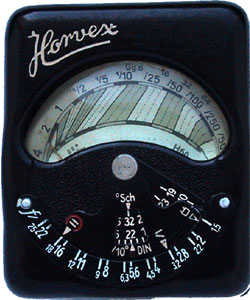
|
 Maker: Metrawatt Model: Horvex Circa: 1938 Designer: A. Bernhard and G. Beyrich US Patent: 2,245,522 Cell type: Selenium Measure type: Reflecting/Averaging |
|
The original Horvex came out just before the war. The Horvex 2 came out around 1955, and the Horvex 3 around 1960. They were also sold in the USA after the war as the Argus L3 line, and I believe they were the basis for the Russian Leningrads as well. Some people call this the H60, as it says H60 on the meter face in the bottom right corner. That may be its true name, but in all the advertising I've seen, it was simply the "Horvex" and there were no other models with the same name, so I simply refer to this as the "Horvex." All the main Horvex meters have something in common: a really nifty add-on in the form of an additional sensor. Selenium sells are photovoltaic, which means they generate electricity when light strikes them. The more light that hits them, the more electricity. But also—the larger the sensor, the more electricity, and the more sensitive it is to low light. I believe this is one of the reasons why Westons and Norwoods were so well regarded: they had larger sensors than most. Anyway, a Horvex's main sensor was a slim rectangle mounted near the front of the meter, like most meters of the time. But you could add the secondary sensor which plugged directly into the circuit and added more juice. The sensor sat perpendicular to the meter and faced in the same direction as the front edge, so both sensors saw the same light. You compensated for it on the calculator dial. This one has a couple of interesting kinks: first, the sensor is mounted on the back, similar to a Weston. But rather than hold it eye-level, there's a door on a hinge you open and it has a mirror. When the door is open, a mirror is set at 45° and reflects the light up onto the sensor, so you still hold the meter at chest-level. I have no idea what the advantage of this would be, but there you are. When the door is closed, a little bit of light can still get in, so door open (mirror down) is for poorer light, and door closed (mirror up) is for bright light. On the calculator dial: when the door is closed you use the pointer on the left with the II symbol (on my photo, it's pointing at 18); with the door open you use the pointer toward the right that has the I/ symbol (on my photograph above, that pointer is aimed at 3.2); with the booster you use the pointer on the far right with the booster symbol (mine is pointing to 1.5 in the photo above). The other unusual feature is that the scale under the meter glass (just above the needle) is connected to the calculator dial, so that when you turn the calculator dial, the inner meter scale rotates with it. So what you do is set the calculator dial to your preferred aperture and direct-read the shutter speed (or frames-per-second) on the meter dial. Special thanks for Daniel Lenel for additional information and corrections to my Horvex description. |
|
©opyright by James Ollinger. All Rights Reserved.
Company names and models are registered trademarks of their respective owners
and are not affiliated with this website in any way.

-sm.jpg)